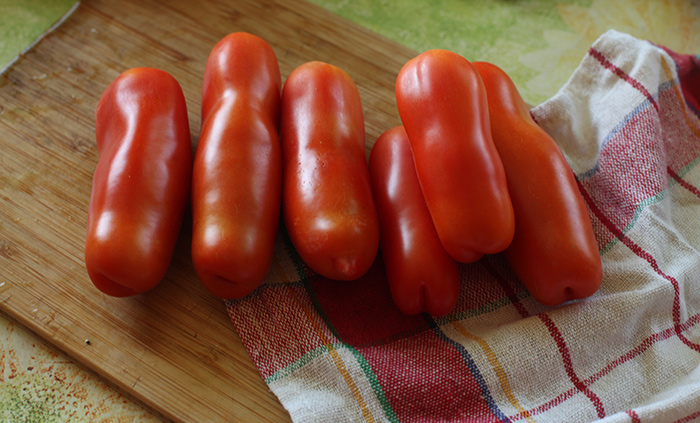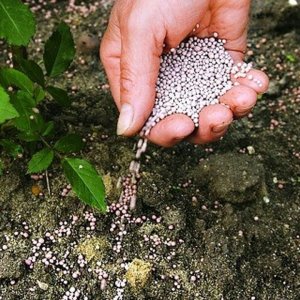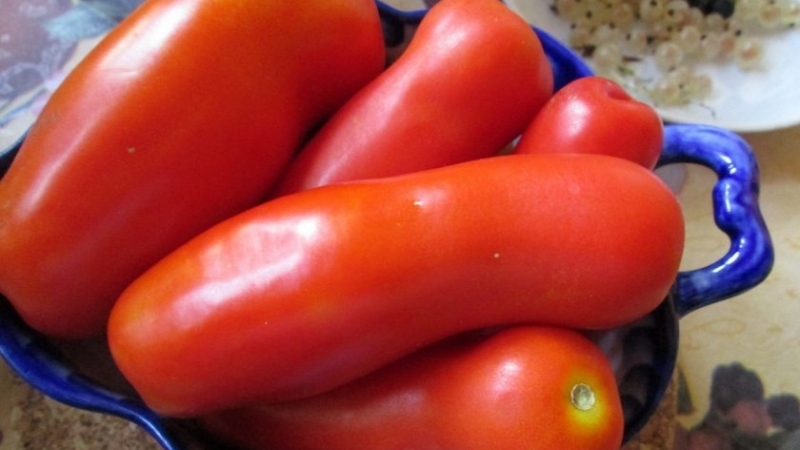What will pleasantly surprise you with an unusual-looking tomato "Zhigalo": reviews, photos and description of agricultural technology
Gigolo is a versatile tomato variety that is suitable for both outdoor cultivation and greenhouse cultivation. Among the advantages of the variety are the compactness of the bush, the interesting shape of the fruits and their wonderful taste. In addition, the Gigolo is suitable for commercial cultivation - the tomatoes tolerate transportation well and have a presentable appearance.
The content of the article
Description of the variety
The determinant shrub of the standard type has a compact root system, due to which the plant does not require a large area in the garden for its nutrition. The multi-fruited stem is stable and withstands fruit-laden brushes.
The bush grows up to 50-60 cm, and under favorable conditions, up to 80 cm. The plant has an average amount of foliage, which has a dense structure and a rich light green hue. Clusters are formed at a distance of 10 cm and bear 5-6 flowers. With the appearance of the third leaflet, the first ovaries begin to form, and the following peduncles are formed through two leaves.
Distinctive features
The Gigolo variety is distinguished by the versatility of the fruit. Tomatoes tolerate transportation well, making them suitable for growing for sale. Tomatoes are often plucked brown, they ripen well outside the garden and are stored for a long time.
Fruit characteristics and yield
Tomatoes are oblong in shape, like a cylinder with bulges. Their length varies from 8-9 to 12-15 cm, and the diameter is from 3 to 4 cm. The weight of one fruit is 100-130 g. Tomatoes have a dense red skin, do not crack, and the fleshy pulp contains few seeds. The fruits are not too juicy in texture, sometimes even dryish, but the taste is pleasant, sweetish, with a slight sourness.

Gigolo tomatoes ripen in medium terms. The culture begins to bear fruit in 95-106 days from the beginning of sprout development. Growing tomatoes in heated greenhouses gives an earlier harvest. One bush of this variety on average gives up to 2-3 kg of tomatoes, and in greenhouse conditions and 5 kg. From 1 sq. m vegetable growers collect 8-15 kg of fruit.
On a note... The fruits of the Gigolo variety ripen at the same time.
How to grow seedlings
It takes two months from the moment of sowing seeds for seedlings to planting a plant in open ground. If planting is planned in May, then the seeds are sown in mid-March. At this time, daylight hours increase, and the plants will receive a sufficient amount of heat and light.
For your information... Vitamin C is found most in the jelly-like liquid around the seeds.
Seed preparation
First of all, pay attention to the presence of a stamp on the package, on which the manufacturer indicates whether the seed has been pre-treated. Untreated seed is sometimes sold. In this case, the preparation of the beans is done independently.
To do this, you need to prepare a special solution, which includes the following ingredients:
- phytosporin;
- aloe juice;
- potassium permanganate.
In this composition, the seeds are kept for 5-8 minutes, after which they are thoroughly rinsed under running water. Planting wet seeds is not recommended. They need to be well dried and only after that they will be ready for planting.
Capacity and soil
Purchased seedling boxes will last a long time, but you can also use what you have at home: cut plastic bottles, disposable cups, pre-assembled and washed juice or milk boxes.
Another good option is peat tablets. They will need to be moistened and the seeds placed in the swollen soil. The seedling store also sells containers with cells and a lid.
Tomato seedlings need loose and light soil. The best option would be to purchase a ready-made mixture with a specially developed composition, but you can do it yourself. To do this, you will need to mix two parts of garden soil and one part of peat and sand in a large container. The day before sowing, the soil mixture is disinfected with boiling water.
Sowing
Before planting, the soil is moistened and holes are made in it with a depth of 2 cm. Seeds are placed in them and sprinkled with earth or clean peat. After sowing, watering is carried out with warm, settled water. Moisten with a sieve or spray bottle so as not to wash the seeds out of the soil, then cover the container with a film and place in a warm place with an air temperature of at least 21˚С.
Important! You cannot over-water the seedlings. Even if the top layer of the soil is dry, the soil inside the container remains sufficiently moist for some time.
Growing and care
When the first sprouts appear, the seedlings are placed on a well-lit windowsill. But in cloudy weather, when there is practically no sun, artificial lighting is used. The correctness of the development of sprouts and the fertility of the plant depend on the amount of ultraviolet radiation.
After 30-40 days, tomato seedlings are hardened. The containers are taken out into the street for an hour or two, then this time is increased.
How to grow tomatoes
When the seedlings have grown to 20 cm, the plant is ready to be transplanted outdoors. Disembarkation dates vary by region, but not earlier than mid-May. They are planted in the greenhouse in the first days.
Landing
When planting seedlings in a permanent growing area, it is important to remember that the bushes should not be planted too close to each other. The distance between them should be about 50-60 cm. If you do not adhere to this rule, the yield will decrease.
Care
The Gigolo tomato variety does not require special attention and care. Avoid over-wetting the soil as the crop root system is close to the soil surface. After glaze it is imperative that loosening is carried out so that the roots receive more oxygen. Moistening is carried out as the earth dries up.
Important! The stems and trunk of the plant are not watered.
The fewer branches on the stem, the larger the tomatoes will be, so pinching is carried out as desired. The lateral processes are neatly cut off, 1–2 cm away from the stem.
The first feeding is applied 2-3 days after thinning the rows. Fertilize with ammonium nitrate (15 g per 10 l of water). Pour a liter of solution under each bush. After feeding, the soil is mulched.
The second feeding of tomatoes is carried out as soon as fruits begin to set on the bushes. For fertilization, a mineral mixture is used (10 g of potassium chloride and 20 g of superphosphate per 1 sq. M). Top dressing is buried and the soil is moistened. For this, shallow grooves (5-6 cm) are made along the rows at a distance of 15-20 cm from the plants.
When fertilizing the soil, nitrogen fertilizers are applied carefully. Excessive use of them will lead to increased growth of the bush and an abundant build-up of green mass. If there are no ready-made mineral fertilizers, then organic feeding is perfect.
To prepare the mullein infusion, stir a quarter of a bucket of manure in 10 liters of water and let it brew for 10-12 days. Before feeding, dilute the solution again (a liter of fertilizer per bucket of water). Feeding consumption: per 1 sq. m pour 10 liters of diluted infusion.
Features of cultivation and possible difficulties
The cultivation of Gigolo tomatoes is no different from the cultivation of other varieties of tomatoes, that is, the seedling method.This means that the sowing of seeds in special boxes is carried out in March-April, two months before the intended planting of seedlings in open ground or a greenhouse.
Attention! The Gigolo variety is grown in all regions of the Russian Federation.
Diseases and pests
The gigolo has medium disease resistance. For the prevention of fungal diseases, the following measures are taken:
- mulch soil;
- diseased and yellow leaves are removed in a timely manner;
- disinfect planting material;
- remove weeds.
So that the plants are not affected by diseases, the culture is supported by the introduction of complex mineral fertilizers. When the air temperature drops, the plants are treated with agents that prevent late blight infection. Tomatoes are sprayed with fungicide solution and Bordeaux liquid.
Bears, slugs and aphids are often found in the tomato garden. Scattering of hot red pepper, mustard, granules of the "Thunderstorm" preparation helps from pests that move along the ground.
Aphids and other insects are destroyed with Fitoverm. Garlic infusion also helps from pests. For cooking, add 200 g of grated garlic or onion in 10 liters of water, and let it brew for a day.
The nuances of growing in open ground and in a greenhouse
Since the variety is undersized and has a strong stem, it is believed that the culture does not need a garter. However, when a large amount of harvest is ripe, the bush can fall down in a strong gust of wind.
To avoid this, during the preparation of the holes, they put supports for the tomatoes. In areas with a warm climate, they do without them. The bushes are laid on the ground, protecting the soil from drying out. The soil is pre-mulched.
On a note. In cool climates, a garter is a must. If the fruits fall to the ground under such conditions, then the plant may get sick.
Harvesting and application of the crop
Harvesting takes place in July-August. Plucked tomatoes have a longer shelf life. The Gigolo tomato variety is used for fresh consumption, they are added to salads and hot dishes. Since the fruits contain a high concentration of dry matter, they make a good sauce. Also, tomatoes are dried, dried and canned.
Advantages and disadvantages of the variety
The Gigolo tomato has a number of advantages that distinguish it favorably from other varieties. The advantages include:
- Unpretentious care. There are no special requirements for the soil, which greatly facilitates the cultivation process.
- Immunity to many diseases.
- In warm regions, the culture does not require a garter.
- The fruits tolerate transportation well and are stored for a long time.

There are also disadvantages:
- Low fruit weight. Most varieties have a more impressive weight, so it is more profitable to sell fruits in bulk. This is a disadvantage in the commercial cultivation of the Gigolo variety.
- Few seeds. When cultivating a variety, you need to be prepared that you will have to collect a lot of grains, given that there are very few of them in the fruits themselves.
- Insufficiently juicy tomato pulp. Gigolo tomatoes are not suitable for juicing.
Farmers reviews
Gardeners speak about the Gigolo tomato mostly positively. These tomatoes have merits and demerits. Consider some of the gardeners' opinions.
Natalia, Voronezh: “That year I grew the Gigolo tomato variety. Small plants grew no more than 50 cm. She was not engaged in grazing and shaping at all. Therefore, the bushes had several trunks. The number of fruits just amazed me and the neighbors. I was especially surprised by the length of the tomatoes - the largest was 15 cm, as in the photo of the package. The taste is not particularly memorable, but the adjika came out great. I will plant this variety next year as well ”.
Julia, Oryol: “The bush is strong, compact, no more than 80 cm high, all covered with tomatoes. Tomatoes taste a little dry, I didn’t like them, in my opinion, they are well suited for preservation. The manufacturer claims that the fruits grow up to 15 cm in length. In fact, 6-9 cm. "
Irina, Mtsensk: “The variety is interesting, compared to ordinary round tomatoes, the Gigolo fruit has an unusual shape. Tomatoes are delicious and have a long shelf life. Also, this vegetable does not wrinkle in the hands when cutting. I really liked the fresh tomatoes, they are well suited for preservation, and this is confirmed on the seed packaging. But for the preparation of salads, I prefer the larger and more meaty varieties. "
Read also:
Beta-carotene champion: Klondike tomato.
Conclusion
Gigolo variety is a real find for lovers of original vegetables. It is easy to care for and gives a bountiful harvest on well-fertilized soil. The fruits have a long shelf life. Tomatoes are able to ripen if they are brown from the brush. Varietal crops can be grown from seeds harvested from their own tomatoes.
You will learn detailed information about growing the Gigolo variety from the following video: